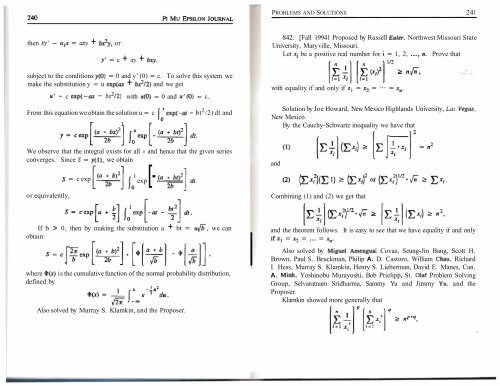PROBLEMS AND SOLUTIONS 239andupward, the area is less than the approximation, that is,After much algebra, during which we find that AIC 2 /27? + 2587 - 27= 30.58472 in order for r to be nonnegative, we find the expectation E tobeIf AIC < i/27? + 2587 - 27, the problem simplifies and you choose onlyfrom sets 1 and 2, taking r = 0, as the reader may wish to verify.Also solved by Paul S. Bruckman, William Chau, Mark Evans, RichardI. Hess, and the Proposer.Editorial note-// is interesting to see a problem where five solverssubmit solutions with five different answers. Some of these differences weredue to different assumptions about strategies and about theconditions of theproblem. Combinatorial and probability problems attract differentinterpretations, clearly illustrated in the recent furor over the so-calledMonty Hall problem.840. [Fall 19941 Proposed by Seung-Jin Bang. Seoul, Republic ofKorea.Prove that, for n S 2,Solution by George P. Evanovich, Saint Peter's college. Jersey City,New Jersey.We have that<strong>No</strong>w add 112 + ll(2n) to each side to obtain the desired result. -. .-Also solved by Alma College Problem Solving Group, Paul S.Bruckman, Mark Evans, Jayanthi Ganapathy , Edward Hamilton, Richard I.Hess, Joe Howard, <strong>Mu</strong>rray S. Klamkin, Henry S. Lieberman, Peter A.Lindstrom, David E. Manes, Can. A. Minh, Yoshinobu <strong>Mu</strong>rayoshi, BobPrielipp, St. Olaf Problem Solving Group, Selvaratnam Sridharma, SammyYu and Jimmy Yu, and the Proposer.841. [Fall 19941 Proposed by Seung-Jin Bang, Seoul. Republic ofKorea.For given real constants a, b, and c, let {a} be the sequence satisfyingthe recursion equation n a = aan-, + ban--, for n > 1, a. = 0, al = c.Find the sum of the seriesSolution by Paul S. Bruckman, Edmonds, Washington.00Initially we ignore questions of convergence. Let S = En ( J ~ . Wefirst deal with degenerate eases. Ifa = b = 0, then clearly S = c. If (J #0 and b = 0, we see that an = ca"'ln! for n '&. 1, and S = (c/rt)(elJ - 1).By letting a -Ã 0 we see that the former case is a limiting instance of thelatter.Henceforth we suppose that b # 0. To develop a differential equation,supposewhose coefficients a satisfy the given recursion equation. SinceDraw the graph of f (x) = I lx and approximate the area under the curve onthe interval [I, n1 by the trapezoidal rule. Since the curve is concave
PROBLEMS AND SOLUTIONS 24 1then xy' - alx = axy + bgY, ory' = c + ay + bxy,subject to the conditions y(0) = 0 and y' (0) = c. To solve this system wemake the substitution y = u exp(ax + b212) and we getu = c exp(-ax - b&) with u(0) = 0 and u'(0) = c.xFrom this equation we obtain the solution u = c f exp(-at - bt 2 /2) dt and0r 1 r 1842. [Fall 19941 Proposed by Russell Euler, <strong>No</strong>rthwest Missouri StateUniversity, Mary ville, Missouri.Let xi be a positive real number for i = 1, 2, . . . , n. Prove that- -with equality if and only if xl = x2 = ... = x,,.Solution by Joe Howard, New Mexico Highlands University, Las Vegas,New Mexico.By the Cauchy-Schwartz inequality we have thatWe observe that the integral exists for all x and hence that the given seriesconverges. Since S = y(l), we obtains = c exp [(a 1: [- $1 exp (a dtor equivalently,andCombining (1) and (2) we get thatIf b > 0, then by making the substitution a + bt = uJb, we canobtainwhere $(-r) is the cumulative function of the normal probability distribution,defined bya .Also solved by <strong>Mu</strong>rray S. Klamkin, and the Proposer.and the theorem follows. It is easy to see that we have equality if and onlyifxl = x2 = ... = xn.Also solved by Miguel Amengual Covas, Seung-Jin Bang, Scott H.Brown, Paul S. Bruckman, Philip A. D. Castoro, William Chau, RichardI. Hess, <strong>Mu</strong>rray S. Klamkin, Henry S. Lieberman, David E. Manes, Can.A. Minh, Yoshinobu <strong>Mu</strong>rayoshi, Bob Prielipp, St. Olaf Problem SolvingGroup, Selvaratnam Sridharma, Sammy Yu and Jimmy Yu, and theProposer.Klarnkin showed more generally that
- Page 2 and 3: PI MU EPSILONVOLUME 10 FALL 1995 NU
- Page 4 and 5: KALMAN AND MATHEWS. TELESCOPING SER
- Page 6 and 7: KALMAN AND MATHEWS, TELESCOPING SER
- Page 8 and 9: KALMAN AND MATHEWS, TELESCOPING SER
- Page 10 and 11: A WEIGHTED AM-GM-HM INEQUALITYDan K
- Page 12 and 13: ON THE GIRTHS OF REGULAR PLANAR GRA
- Page 14 and 15: Acknowledgment: The author would li
- Page 16 and 17: VARBALOW AND VELLA, FACTORIZATION O
- Page 18 and 19: VARBALOW AND VELLA, FACTORIZATION O
- Page 20: VARBALOW AND VELLA, FACTORIZATION O
- Page 23 and 24: CONJECTURE 3: z(p2) = pZ(p) for all
- Page 25 and 26: Rachele DernbowskiSUNY, Stony Brook
- Page 27 and 28: SEME, HASSE SUBGROUP DIAGRAMS 217wh
- Page 29: pylp? ...p~...p? ...p? > - A.Applyi
- Page 33 and 34: PROBLEMS AND SOLUTIONS 229married c
- Page 35 and 36: PROBLEMS AND SOLUTIONS836. [Fall 19
- Page 37: PROBLEMS AND SOLUTIONS91, 92, a tot
- Page 41 and 42: that:a) Triangles ABC. PQR,and W7.
- Page 43 and 44: 248 Pi MU EPSILON JOURNALso that x
- Page 45 and 46: 252 PI Mu EPSILON JOURNALcertain. A
- Page 47: Subscription and Change of AddressI
















